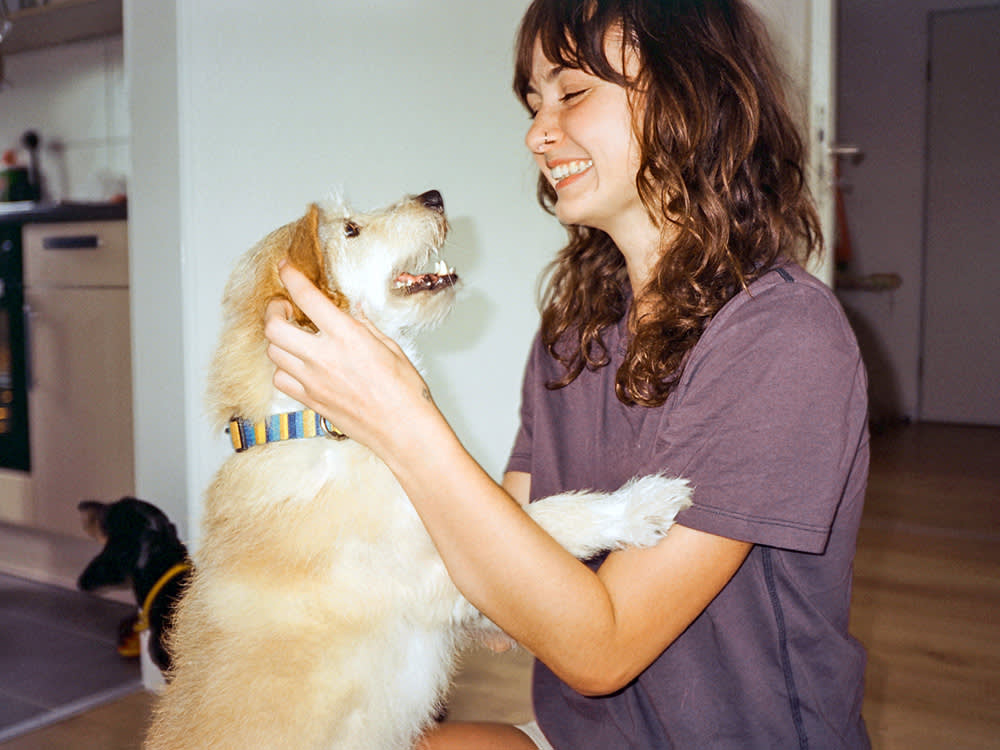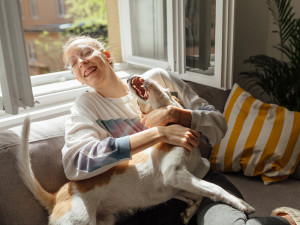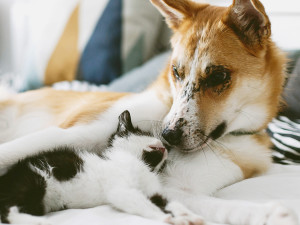What to Expect When You Bring Home a New Dog from a Shelter
Plus, four things you should do immediately.
You finally did it. After months of scrolling through rescue Instagrams and humane society websites, you’ve adopted the perfect shelter dog. But, uh… now, what?
When bringing home a rescueopens in new tab, it’s crucial to meet them where they’re at and to know that their demeanor might change over time. To learn what behaviors to expect from shelter dogs, we spoke with two experts who offered their best tips to set new pet parents up for success.
Do shelter dogs have behavior problems?
In some circles, shelter dogs have gotten a bad rap for being unruly or even aggressive. While this may be the case for some dogs, rescue or otherwise, it’s often the result of a slow escalation. With the right behavior modification training, we can interrupt these behaviors before they become solidified habits.
Learn about dogs’ body language
Dogs rarely become aggressive, lunge, or bite out of nowhere. Instead, they usually show their stress through body language before acting out. No matter where your dog came from, understanding how they communicate will help you better understand their needs and prevent aggressive behavior toward yourself, strangers, and other dogs.
How much do you spend on your pet per year?
“As a guardian, knowing how to read your dog’s body language, understanding what aggression escalation looks like, and the various states of canine maturity and what they entail, is so important,” says certified dog behavior consultant and Shelter Behavior Integrationsopens in new tab owner Laurie Lawless .
Certified dog behavior consultant and accredited dog trainer Emily Scottopens in new tab agrees that body language is a crucial “barometer” for gauging your dog’s comfort zone.
Signs your dog is stressed or scared can include:
Low, stiff posture
Shaking or jumpiness
Growling or snarling
Excessive lip-licking
Raised hackles
Ears pinned down or pointed forward
Tail between legs
Wide “whale eyes” or rapid eye movement
If your dog seems anxious, stop whatever you’re doing, and let them retreat to a place that feels safe. Don’t force them to continue the activity that makes them uncomfortable without consulting a professional; that’ll only make things worse.
Behaviors to expect from shelter dogs in the first few weeks
Every dog is different, so their reactions to a new home will naturally vary as well. That said, there are some shared themes.
Scott says it’s common for shelter dogs to be warm and loving toward only some members of the family. Based on their prior history, they might be skittish around small children, men, or another group. If you notice this, avoid having that family shower your dog with unwanted attention, hugs, and interactions. Instead, let the dog adjust to their presence slowly and interact when they feel confident.
Your new dog might also run into some potty issues. “They don’t know where they’re supposed to go in this new setting, so they have accidents,” Scott says.
This is especially common during the first day or two, even for potty trained dogs, Lawless says. “Transition can be challenging, so even simple behaviors can be totally upended.” If your new dog is having accidents, be patient, and remember that these problems are temporary.
Behaviors to expect from shelter dogs in the long term
It can take months for a dog to begin feeling comfortable, Scott says, and up to a year before they feel truly acclimated to their new routines. However your dog acts when they first come home, there’s a good chance their full personality won’t emerge until after they’ve settled.
“Some dogs act out right away and then settle in with routine and consistency, and other dogs will suppress behaviors under initial stress and then show more behaviors once they are comfortable,” Lawless says.
Even dogs that are quiet upon arrival might grow territorial over time, once they realize that your home is also their home. “When they first come into the home, they don’t know it's their property,” Scott says. “...But as they get accustomed to being in this environment and realize, This is my territory, it’s very common to see the barking come out.”
If your dog becomes territorial, try giving them treats when the doorbell rings to curb their fear a nd build a positive association. You might also put them in another room to deduce the stress of involving them in the greeting process. If that doesn’t work, consider hiring a trained professional to help.
If you notice your dog reacting to a particular situation in a new way more than once — especially if they display fear, anxiety, or aggression — Lawless suggests journaling to track both the behavior and any attempts you make to mitigate it. “If it gets to a point in which you need to reach out for help,” she says, “ trainers will first want to look at behavioral patterns and initial interventions so their training plan can be most effective and efficient from the get go.”
Four tips for bringing home a shelter dog
When adopting a rescue dog, take these steps for a smoother transition.
Be flexible.
Whenever bringing home a new pet, it’s tempting to start having fun right away. But flooding your dog with new experiences could overwhelm them and make the adjustment period that much harder. “All dogs need time to decompress,” Scott says.
When they first arrive, “most dogs are still kind of traumatized from being in the shelter and foster care, and/or on the streets,” Scott says. “They're still just trying to navigate living in the human world, let alone going to games and concerts and restaurants and dog parks.” That’s why it’s best to “go a lot slower than you think.”
Early on, let your new dog negotiate their new environment gradually. Don’t force them to interact with you if they’re not ready, and don’t invite the whole family over to greet them. Once you are able to receive guests, invite one or two at a time. Dissuade visitors from forcing social interactions and let the dog come to them instead.
If your dog is scared of the leash, don’t drag them outside anyway; speak with a trainer who can help them overcome that fear. Whatever happens, be compassionate and remember how much new information your dog is processing at once — right down to learning their own name. This is a learning process for both of you.
Set up safe spaces in your home.
Before you bring your shelter dog home, identify some places where they can safely sleep, sit, and eat.
Planning is important, and so is paying attention to how your dog responds to their new set-up. “You may set up a crate, a bed, and a feeding area where you envision the dog would use those items,” Lawless says, “but allowing the dog to choose their preferences as much as possible is very important in allowing them to settle in.”
If you’ve set up a new crate on one side of the bed, but your dog actually seems to prefer the other side, consider shifting items around. If you set up your dog’s eating station in the kitchen only to find out that the area intimidates them, try moving the bowl somewhere quieter. The goal is to be both considerate and receptive to new information as your pet gives it to you.
Establish a routine.
Lawless and Scott agree that following predictable routines is key. Feed and walk your dog at the same time each day to help them get the lay of the land and build confidence.
Whatever your dog’s exercise needs might be, find ways to build that activity into your day as well. As Lawless notes, “Dogs who don’t have their physiological needs met will figure out how to do so on their own, and it's definitely not going to be in the way most households will find constructive.”
It can also help to limit your dog’s access to certain items and areas in your home while they explore — particularly those that could inspire unwanted behaviors. For example, Lawless notes that many dogs will try to get into garbage cans or steal snacks stored on the kitchen counter. Consider securing those items and using boundaries, like baby gates, to keep your dog at bay. That way, they can learn the house rules after they’ve started feeling safe.
Prepare your existing pets.
If you already have another dog in your home (or a cat, or a bird, or anything else), foster healthy relationships between them by establishing boundaries.
“If you have a multi-dog household, it’s important to prepare your current dog for both dogs to have their routines changed,” Lawless says. “If you need to make adjustments to furniture or the household, doing that a few days to a week ahead of time can be helpful.”
Set up a barrier for the first introduction, like a baby gate, to help your dogs get acquainted from a safe distance. Once they seem used to each other and express friendly interest, remove the barrier and let them greet one another up close.
Even after your dogs start sharing space, keep their eating areas separate to dissuade competition and food aggression. Similarly, put away any toys or treats that could inspire rivalry; let the dogs get used to one another before slowly reintroducing the toys.
How do I make a behavior modification plan for my shelter dog?
If your dog is exhibiting new, unwanted behaviors, a trained specialist can help you overcome them with gentle techniques based in positive reinforcement.
What is behavior modification?
As defined by the American Animal Hospital Associationopens in new tab, behavior modification uses techniques, like rewarding good behavior, to encourage repetition and desensitizing dogs to their triggers through gradual, carefully calculated exposure. Typically, this approach avoids using fear- and punishment-based techniques.
When should I look into behavior modification for my shelter dog?
“Training should start right away,” Scott says. The sooner you start, the smoother the results will be, because habits have had less time to solidify. Lawless agrees: “Don’t wait until something bad happens to get in touch with an expert.”
References
“Changing Behaviors.” AAHA, 5 Aug. 2024, www.aaha.org/resources/2015-aaha-canine-and-feline-behavior-management-guidelines/changing-behaviors/.











